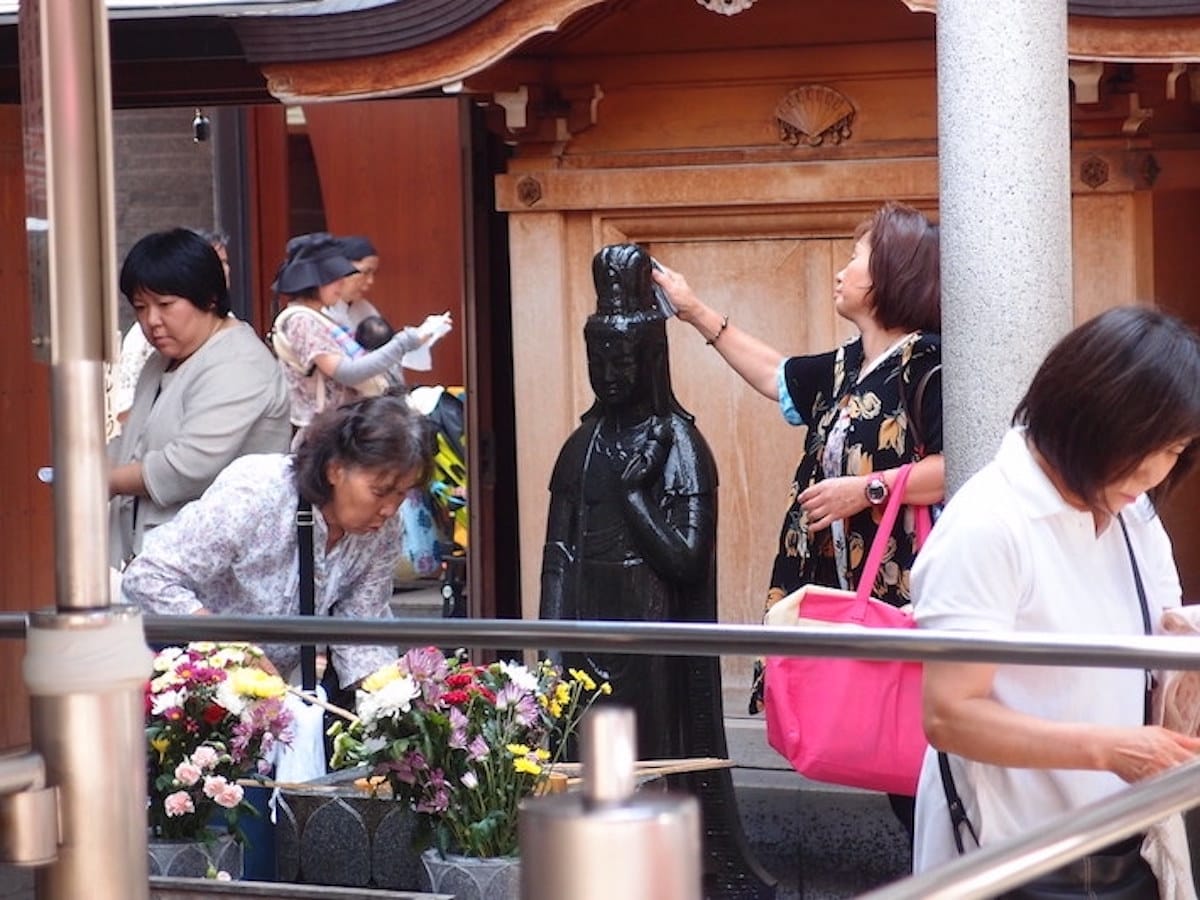
Source: Visitors tending to the Togenuki (splinter-removing) jizō (small statue of the Bodhisattva Jizō) at Kōganji in Sugamo. | Guilhem Vellut, CC by SA 2.0 / © Flickr.com
Cures and remedies and the Tokyo temples and shrines that dispense them
- Tags:
- cures / Japanese temples / remedies


Prudence and caution are highly valued in Japan. Perhaps that's why, despite making up just 1.7% of the world’s population, the Japanese pay 18% of the world’s insurance premiums (according to insurer Manulife).1
In Japan, there is an insurance policy for every imaginable eventuality. Susceptibility to earthquakes only goes some way to explaining this obsession with the worst-case scenario. This is a thoroughly risk-averse society.
The same 'just-in-case' mentality drives much of Japan's pharmaceutical industry. Compared to people in most other countries, the Japanese enjoy a high standard of living, an excellent diet, and as a result, and the highest life expectancy rates on the planet, but that doesn't deter them from keeping extremely well-stocked medicine cabinets.
Japan is the world’s third-biggest pharmaceuticals market, behind only the United States and China, with a pharma market worth around US$95 billion, according to figures from the country’s Ministry of Health, Labour and Welfare (MHLW).2
The size of the pharma market is partly explained by the preponderance of pensioners, who tend to suffer more ailments and take more pills and potions. Older people need more medicine to prevent as well as to cure ailments.
That is no secret to pharmaceutical companies across the globe, who recognise that Japan’s rapidly aging population presents a unique business opportunity. Japanese firms have a particularly strong standing in their home market, making up six of the country’s top ten pharma companies, and the likes of Takeda, Daiichi Sankyo, and Chugai are now significant global players.
An ageing society, the advent of 24-hour pharmacists, and growing numbers of 'the worried well' have turned health into a booming industry, which is something of a mystery when you consider how safe, healthy, and predictable life in modern Japan has become.
OECD pharmaceuticals expenditure. | Yuasan, CC0, via Wikimedia Commons
Yet even before the arrival of western medicine, Japanese people were notable for their caution and prudence. There was a host of native remedies to choose from and many people still turn to them before they make a trip to a pharmacy. This is particularly noticeable in the Kansai region, which still has more acupuncturists, masseurs and moxa treatment specialists than the rest of the country.3
Native remedies aside, for most of Japanese history, the most popular way to treat an illness or affliction was by appealing to the gods. As a result, many Tokyo shrines and temples have become associated with health and healing.
Kōganji 高岩寺 in Sugamo 巣鴨 has a Togenukijizō (刺抜き地蔵 splinter-removing jizō, a jizō being a small statue of the Bodhisattva Jizō). It is said that if you wash the part of the statue that corresponds to the part of your body that hurts, you will be cured of your ailment. Unfortunately, the statue is normally hidden from public view, but people still come to Kōganji to pray to a picture of the statue, copies of which are available in the temple's main hall.
Another temple famous for its medicinal properties is Tōgaku-ji temple 東覚寺 near Tabata 田端. It has two Niō (仁王 statue of a Buddhist protective deity) at the entrance to the temple. They are called ‘red-paper Niō’ because it is said that if you stick a piece of red paper to the part of the statue corresponding to the part of your body that hurts, the pain will go away.
Red banners outside Tōgaku-ji temple, Tabata, Kita-ku, Tokyo. | Kentin, CC BY-SA 4.0, via Wikimedia Commons
Some people believe that the Earthenware Bowl Jizō of Daienji temple 大圓寺 in Mukōgaoka 向ヶ丘 can cure headaches, and any pain in the throat, eyes, head or mouth. All you have to do is write your name, address, and ailment on a piece of paper, put it in an earthenware bowl, put the bowl on top of the jizō’s head and your pain will disappear.
Tokyo also has medicinal landmarks that have nothing to do with religion per se. In the days when the city was called Edo, some people believed that clutching the railings of the bridge at Nihonbashi 日本橋 would cure whooping cough. It was also said that clutching the railings at Kyōbashi 京橋 would do the same for a headache.
Thankfully, these days, most of the diseases that ailed the people of Edo can be easily treated at a doctor's surgery. But there remain some conditions that even modern medicine cannot treat or cure. One is kinketsubyō (金欠病 'lack-of-money disease’); only the gods can offer hope of relief for that one. Sufferers are advised to make an offering at Ushi-Tenjin Kitano shrine 牛天神北野神社 near Koishikawa 小石川 - and pray.
Sources:
1. True Crime Japan: Thieves, Rascals, Killers and Dope Heads: True Stories from a Japanese Courtroom, Paul Murphy, Tuttle 2016, p.19
2. "Top 10 Pharma Companies in Japan," by Dina Spencer, June 12th, 2020, Pharma Boardroom
3. "Introduction to Japanese Society," Yoshio Sugimoto, Cambridge 2014, p.70
Popular cures information is taken from "Tokyo: City of Stories," Paul Waley, Weatherhill 1991, p.208